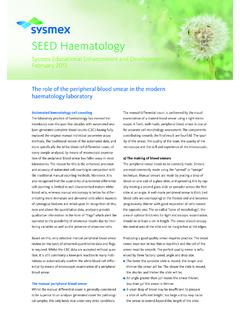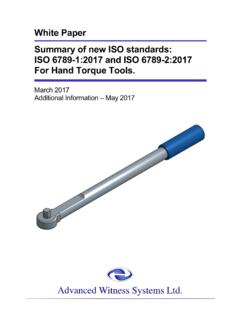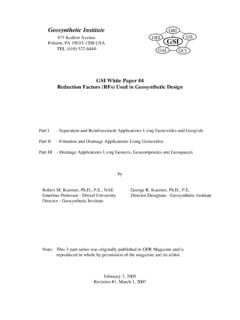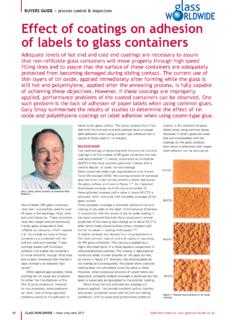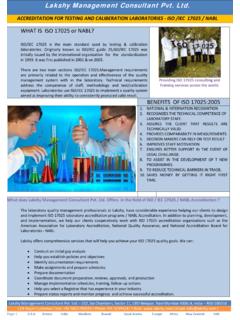Transcription of WHITE BLOOD CELL FUNCTIONALITY - Sysmex …
1 1 | 7 HAEMATOLOGY | MARCH 2017 WHITE PAPERWHITE BLOOD CELL FUNCTIONALITYD ifferentiate with confidence between malignant and reactive conditionsFailing to identify malignant conditions is one of clinical laboratories greatest concerns as it has serious implica-tions for patients health. Avoiding false negative results and detecting all malignant samples with the greatest possible sensitivity is therefore crucial. Relying on man-ual smear reviews is not recommended as this introduces high variability in interpreting lymphocyte morphology. There is also high statistical variation at low counts. Auto-mated haematology analysers can help out here. Yet it s not just about great sensitivity. Once a malignant condition is suspected, laboratories need to perform time-consuming and expensive follow-up tests.
2 As such, analysers also have to exclude false positive results so one can deliver diagnoses faster and keep costs under control. By combining results from the XN-DIFF analysis and the WHITE precursor and pathological cell (WPC) channel, Sysmex XN-Series delivers both highly sensitive and specific detection of reactive and malignant samples. The XN-DIFF measurement In the WHITE BLOOD cell differential (WDF) channel, fluoro-chrome labelling depends on the WHITE BLOOD cells mem-brane composition and cytoplasmic content. The lipid membrane composition of activated or immature cells is different to that of non-reactive and mature cells . A unique combination of reagents (lysis and labelling) and incubation time permits to separate different cell popu-lations.
3 First, the lysis reagent perforates cell membranes, whereby the extent of membrane damage depends on the lipid composition, which in turn depends on the cell type (maturity level) and the state of the cell (activation status). Combining two analysis channels using fluorescence flow cytometry inside a single analyser lets you detect malignancies sensitively and specifically. This is achieved by using the differences in cell FUNCTIONALITY of the different WHITE BLOOD assessment of WBC functionalityand greater workflow efficiency2 | 7 Sysmex WHITE paper WBC FUNCTIONALITY | March 2017 Fig. 1 Fluorescence micrographs of three cellular populations after labelling with WDF and WPC reagents. The WDF fluorochrome marker labels mostly the RNA in the cytoplasm whereas the WPC fluorochrome marker labels mostly the DNA in the nucleus.
4 Bar width = 5 m. Adapted from Kawauchi et al. [1].Next, the fluorochrome marker labels mostly RNA in the cytoplasm (Fig. 1). The intensity of the resulting fluorescence signal depends on the degree of membrane perforation (lipid composition) and the total amount of RNA in the cytoplasm. The information about membrane composition and cytoplasmic RNA (fluorescence), cell volume (forward scatter) and intracellular structure (side scatter) is ana-lysed with proprietary algorithms that deliver sensitive detection of reactive, immature or pathological cells in a BLOOD WHITE precursor and pathological cell (WPC) channel The WPC channel s lysis reagent has a greater effect on the membrane lipids due to a different surfactant and a longer incubation time compared to the WDF channel.
5 In addition, the fluorescence reagent has a higher polymethine con-centration and, consequently, the DNA of the nucleus is labelled. An example of how membrane lipid composition is affect - ed by a cell s FUNCTIONALITY or activation status is the presence of so-called lipid rafts . Lipid rafts are cholesterol- and glycosphingolipid-rich microdomains in the cellular plasma membranes that play important roles in protein trafficking and cellular signalling. Lipid rafts are more ordered and tightly packed than the surrounding mem-brane bilayer, but float freely in this bilayer. Elevated levels of lipid rafts in the cell membrane have been reported in more active cells in extracellular commu-nication ( malignant and activated mature cells ) compared to resting mature cells and immature cells [2 3].
6 The greater permeabilisation of some cell types, such as abnormal lymphocytes, leads to cytoplasmic loss and a smaller cell size (forward scatter signal). Therefore, while the WDF channel hints mostly at cytoplasmic activity, the WPC channel detects abnormal cells by their membranecomposition, resulting in differences in size (shrinkage of some cell types) and higher access to the DNA content, which gets labelled more intensively (Fig. 1).By combining both channels and their respective sets of reagents and reaction conditions both the sensitivity and specificity for detecting reactive and malignant cells is optimised. As illustrated in Fig. 2, the WDF channel can finally identify most of the negative and some of the reac-tive samples.
7 Some samples are suspected of containing either malignant or normal cells (Fig. 2: Malignant or neg-ative? ), while others are suspected of containing either malignant or reactive cells (Fig. 2: Malignant or reactive? ). Samples that fall into either of these two categories are then further classified by an automated reflex measure-ment in the WPC channel. The WPC channel can classify suspect samples into one of three clearly defined categories (reactive, suspected malig-nant or negative). This lets laboratories classify all samples into one of those categories and characterise reactive conditions further, once a malignant condition has been excluded. These categories translate into analyser flags that have the following meaning: suspected malignant means the triggering of either Blasts?
8 Or Abn Lympho? flags, whereas reactive refers to the flag Atypcial Lympho? . In doing so, the XN-Series analysers support the idea of classifying lymphocytes according to the European con-sensus report on BLOOD cell identification, which suggests, for grouping atypical lymphocytes, the use of the groups Atypical lymphocytes, suspect reactive and Atypical lymphocytes, suspect neoplastic [4].Fig. 2 The Sysmex XN-Series dual-level approach to classify samples into three different, well-defined categories: negative, reactive ( flag Atypical Lympho? ) and suspected malignant (either flag Blasts? or flag Abn Lympho? ). Diagnostic level 1 Diagnostic level 2 NegativeXN-DIFFWPCN egativeReactiveReactiveSuspected malignantSuspected malignantMalignant or negative?
9 Automated reflex testAutomated reflex testMalignant or reactive?WDFWPCM onocytesLymphocytesNeutrophils 3 | 7 Sysmex WHITE paper WBC FUNCTIONALITY | March 2017A recent study [5] showed that the XN-Series has a supe-rior sensitivity for blasts and abnormal lymphocytes in a large inter-instrument comparison of pathological flags in 349 samples taken randomly from routine analysis (Table 1). Another recent study [6] found very good performance of the XN-Series in detecting leucocytosis of neoplastic and reactive origin (Table 2). The authors concluded that the XN-Series analyser has a sensitivity and specificity similar to morphological slide based on microscopy, immune phenotyping and clinical diagnosisNAnalyserSensi tivity (%)Speci ficity (%)Positive predictive value (%)Negative predictive value (%)Blasts ( Blasts?)
10 Flag)30 Morphology93999099XE-210090391797XN-2000 93967499 Lymphoma cells ( Abn Lympho? flag)18 Morphology89998999XE-210078621497XN-2000 89977099 Neoplastic cells ( Blasts? and/or Abn Lympho? flags)48 Morphology92989298XE-210085412592XN-2000 94937599 Reactive lymphocytes ( Atypical Lympho? flag)35 Morphology9110097100XE-210063773198XN-20 0086988699 Table 1 Sensitivity, specificity, positive and negative predictive value for flagging pathological samples on five different analysers, using 349 samples taken randomly from routine analysis. Adapted from Bruegel et al. [5].Table 2 Performance of the XN-Series for detecting WHITE BLOOD cells of reactive and neoplastic origin. Adapted from Schuff-Werner et al. [6].
